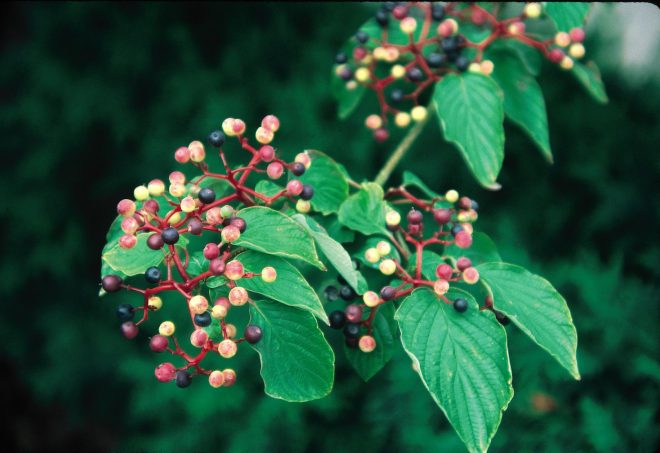Color through the seasons!
Published 9:44 am Monday, May 5, 2025

- PAGODA A PRETTY CHOICE: The Pagoda Dogwood forms beautiful pale-yellow flowers in spring. (National Garden Bureau)
“May, more than any other month of the year, wants us to feel most alive.” – Fennel Hudson.
“All things seem possible in May.” – Edwin Way Teale.
“May, queen of blossoms, and fulfilling flowers, with what pretty music shall we charm the hours?” – Edward Thurlow.
“You are as welcome as the flowers in May.” – Charles Macklin.
“At last came the golden month of the wild folk– honey-sweet May, when the birds come back, and the flowers come out, and the air is full of the sunrise scents and songs of the dawning year.” – Samuel Scoville Jr.
“Sweet May hath come to love us, flowers, trees, their blossoms don; and through the blue heavens above us the very clouds move on.” – Heinrich Heine.
“Among the changing months, May stands confest the sweetest, and in fairest colors dressed.” – James Thomson.
Dogwoods are versatile plants that can add beauty to any garden, with their vibrant flowers, colorful stems, and berries. With dozens of species across the world, dogwood has been a part of human history for centuries. And since the 1800s, this group of trees and shrubs has become a garden favorite in North America. From stunning flowers to colorful stems and berries, these plants offer qualities that are right at home in gardens. Among the tree species, you’ll find showy flowers, distinct bark, and beautiful form. Then you have the shrubs, which offer colorful stems and a range of sizes to fit your garden needs. And that’s not all! Many dogwoods are native to North America, making them useful for local insects and wildlife.
From woodworking to medicine, dogwoods have found a place in the history books. The genus was likely named for its dense wood, which was often used to make tools. And for many people, their spring blooms are considered a symbol of rebirth and renewal. When Native Americans saw the dogwoods blooming, they knew it was time to plant their crops.
Among the many dogwood species, there are two categories: shrubs and trees. Some of the common trees include: Pagoda dogwood (Cornus alternifolia), Kousa dogwood (Cornus kousa), and Flowering dogwood (Cornus florida). These species are often found in the understory of forests, so they’re a great choice for landscapes with part shade. When you look at the flowers of C. kousa and C. florida, the colorful petals are really bracts, a type of modified leaf that changes color. The true flowers are very small and can be found at the center of the bracts.
Shrub dogwoods can be found growing in moist soils across North America. A few species you might find are: Tatarian dogwood (Cornus alba), Redtwig dogwood (Cornus sericea), and Gray dogwood (Cornus racemosa). Both C. alba and C. sericea are known for their colorful stems, which really stand out in winter. While the stems of C. racemosa are less colorful, the plant produces beautiful clusters of white berries.
Popular varieties/series include: First Editions® Collection including Neon Burst™ dogwood featuring Chartreuse leaves that retain their bright color throughout the summer then turn to a rainbow of purple, red, yellow, and orange in autumn. The glossy scarlet red stems provide winter interest to the landscape. Also, Firedance™ dogwood with compact, uniform habit which is ideal for small areas and features red-purple leaves during fall, pure white flowers in spring leading to summer fruit.
Proven Winners Series include Arctic Fire® red dogwood with compact growth that remains 3-4’ tall and wide and provides dark red winter stems. It has a non-suckering habit and upright shape. Also, Sgt. Pepper™ dogwood featuring bright green and cream leaves with pale pink margins, red fall leaf color that accents the red stems offering deer-resistance and durability.
Monrovia Series include Kelsey’s Dwarf Red-Osier dogwood with beautiful compact and tidy round shape oiffering green foliage with striking red stems for winter landscape. It grows only 24 to 30 inches tall and wide. Also, Ivory Halo® dogwood featuring colorful red stems for winter interest and variegated foliage with light green leaves with creamy white margins, growing 5 to 6 feet tall and wide.
The tree dogwoods include Chinese Kousa dogwood which is a small tree with large white bracts in spring featuring an upright habit with horizontal branching. It has edible fruit and attractive fall color. Also, Pagoda dogwood which forms beautiful pale-yellow flowers in spring with branches that have a unique layered structure. It’s attractive leaves turn maroon red in fall. And, Golden Shadows® Pagoda dogwood featuring variegated foliage, elegant, striking habit with year-round interest.
And the Flowering dogwood which is a popular choice in woodland gardens, mixed borders and specimen plantings. Its compact size and stunning seasonal displays make it ideal for small gardens and urban landscapes. Its berries attract a variety of birds including cardinals, bluebirds, blue jays, mockingbirds and cedar waxwings, as well as providing shelter and nesting sites for wildlife. The fruit of the flowering dogwood is poisonous to humans.
“But thanks be to God! He gives us the victory through our Lord Jesus Christ. Therefore, my dear brothers, stand firm. Let nothing move you. Always give yourselves fully to the work of the Lord, because you know that your labor in the Lord is not in vain.” 1 Corinthians 15:57-58. “The grace of the Lord Jesus Christ be with your spirit. Amen.” Philippians 4:23. “If My people, who are called by My name, will humble themselves and pray and seek My face and turn from their wicked ways, then will I hear from heaven and will forgive their sin and will heal their land.” 2 Chronicles 7:14. “I lift up my eyes to the hills — where does my help come from? My help comes from the Lord, the Maker of heaven and earth. He will not let your foot slip — He who watches over you will not slumber…” Psalm 121:1-3.





